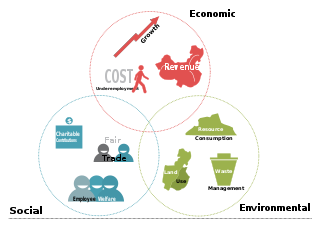
The triple bottom line is an accounting framework with three parts: social, environmental and financial. Some organizations have adopted the TBL framework to evaluate their performance in a broader perspective to create greater business value. Business writer John Elkington claims to have coined the phrase in 1994.

Corporate social responsibility (CSR) is a type of international private business self-regulation that aims to contribute to societal goals of a philanthropic, activist, or charitable nature by engaging in or supporting volunteering or ethically-oriented practices. While once it was possible to describe CSR as an internal organisational policy or a corporate ethic strategy, that time has passed as various international laws have been developed and various organisations have used their authority to push it beyond individual or even industry-wide initiatives. While it has been considered a form of corporate self-regulation for some time, over the last decade or so it has moved considerably from voluntary decisions at the level of individual organizations to mandatory schemes at regional, national, and international levels.
Social responsibility is an ethical framework and suggests that an individual has an obligation to work and cooperate with other individuals and organizations for the benefit of society at large. Social responsibility is a duty every individual has to perform so as to maintain a balance between the economy and the ecosystems. A trade-off may exist between economic development, in the material sense, and the welfare of the society and environment, though this has been challenged by many reports over the past decade. Social responsibility means sustaining the equilibrium between the two. It pertains not only to business organizations but also to everyone whose any action impacts the environment. It is a concept that aims to ensure secure healthcare for the people living in rural areas and eliminate all barriers like distance, financial condition, etc. Another example is keeping the outdoors free of trash and litter by using the ethical framework combining the resources of land managers, municipalities, non-profits, educational institutions, businesses, manufacturers, and individual volunteers will be required to solve the ocean microplastics crisis. This responsibility can be passive, by avoiding engaging in socially harmful acts, or active, by performing activities that directly advance social goals. Social responsibility must be intergenerational since the actions of one generation have consequences on those following.
A social enterprise is an organization that applies commercial strategies to maximize improvements in financial, social and environmental, the Triple bottom line, well-being—this may include maximizing social impact alongside profits for co-owners.
Double bottom line seeks to extend the conventional bottom line, which measures fiscal performance—financial profit or loss—by adding a second bottom line to measure a for-profit business's performance in terms of positive social impact. There is controversy about how to measure the double bottom line, especially since the use of the term "bottom line" implies some form of quantification. A 2004 report by the Center for Responsible Business noted that while there are "generally accepted principles of accounting" for financial returns, "A comparable standard for social impact accounting does not yet exist." Social return on investment has been suggested as a way to quantify the second bottom line.
Social return on investment (SROI) is a principles-based method for measuring extra-financial value. It can be used by any entity to evaluate impact on stakeholders, identify ways to improve performance, and enhance the performance of investments.
Social venture capital is a form of investment funding that is usually funded by a group of social venture capitalists or an impact investor to provide seed-funding investment, usually in a for-profit social enterprise, in return to achieve an outsized gain in financial return while delivering social impact to the world. There are various organizations, such as Venture Philanthropy (VP) companies and nonprofit organizations, that deploy a simple venture capital strategy model to fund nonprofit events, social enterprises, or activities that deliver a high social impact or a strong social causes for their existence. There are also regionally focused organizations that target a specific region of the world, to help build and support the local community in a social cause.

Social entrepreneurship is an approach by individuals, groups, start-up companies or entrepreneurs, in which they develop, fund and implement solutions to social, cultural, or environmental issues. This concept may be applied to a wide range of organizations, which vary in size, aims, and beliefs. For-profit entrepreneurs typically measure performance using business metrics like profit, revenues and increases in stock prices. Social entrepreneurs, however, are either non-profits, or they blend for-profit goals with generating a positive "return to society". Therefore, they use different metrics. Social entrepreneurship typically attempts to further broad social, cultural and environmental goals often associated with the voluntary sector in areas such as poverty alleviation, health care and community development.
An ethical bank, also known as a social, alternative, civic, or sustainable bank, is a bank concerned with the social and environmental impacts of its investments and loans. The ethical banking movement includes: ethical investment, impact investment, socially responsible investment, corporate social responsibility, and is also related to such movements as the fair trade movement, ethical consumerism, and social enterprise.

Acumen is a non-profit impact investment fund with over 15 years’ experience in investing in social enterprises that serve low-income communities in developing countries across Sub-Saharan Africa, South Asia, Latin America, and the United States. It aims to demonstrate that small amounts of philanthropic capital, combined with large doses of business acumen can result in thriving enterprises that serve vast numbers of the poor. Over the years, Acumen has invested $115 million in 113 companies and has had a successful track record in sourcing and executing investment opportunities in the clean energy, health care and agriculture sectors.
Social business was defined by Nobel Peace Prize laureate Professor Muhammad Yunus and is described in his books.

Socially responsible investing (SRI), social investment, sustainable socially conscious, "green" or ethical investing, is any investment strategy which seeks to consider both financial return and social/environmental good to bring about social change regarded as positive by proponents. Socially responsible investments often constitute a small percentage of total funds invested by corporations and are riddled with obstacles.

A philanthropreneur is an entrepreneurial philanthropist. The term is claimed to be coined by Internet entrepreneur Mark Desvaux in 2004; however, The Wall Street Journal used the term in a 1999 article, and a publication entitled The Philanthropreneur Newsletter existed as far back as 1997. Philanthropreneurship is often considered the start of a new era in philanthropy, characterized by the development of the philanthropist’s role and the integration of business practices.

Social finance is a category of financial services which aims to leverage private capital to address challenges in areas of social and environmental need. Having gained popularity in the aftermath of the 2008 Global Financial Crisis, it is notable for its public benefit focus. Mechanisms of creating shared social value are not new, however, social finance is conceptually unique as an approach to solving social problems while simultaneously creating economic value. Unlike philanthropy, which has a similar mission-motive, social finance secures its own sustainability by being profitable for investors. Capital providers lend to social enterprises who in turn, by investing borrowed funds in socially beneficial initiatives, deliver investors measurable social returns in addition to traditional financial returns on their investment.

Humanistic capitalism is a concept that seeks to marry humanism, specifically the safety and health needs of people and the environment, with an embrace of market forces and a market-based economy.
Return on investment (ROI) or return on costs (ROC) is a ratio between net income and investment. A high ROI means the investment's gains compare favourably to its cost. As a performance measure, ROI is used to evaluate the efficiency of an investment or to compare the efficiencies of several different investments. In economic terms, it is one way of relating profits to capital invested.

Patient capital is another name for long term capital. With patient capital, the investor is willing to make a financial investment in a business with no expectation of turning a quick profit. Instead, the investor is willing to forgo an immediate return in anticipation of more substantial returns down the road. Prominent examples of patient capital includes pensions, sovereign wealth funds, and university endowments.
Impact investing refers to investments "made into companies, organizations, and funds with the intention to generate a measurable, beneficial social or environmental impact alongside a financial return". Impact investments provide capital to address social and/or environmental issues.
Environmental, Social, and Corporate Governance (ESG) refers to the three central factors in measuring the sustainability and societal impact of an investment in a company or business.
E+Co is a non-governmental organization based in Bloomfield, New Jersey, United States, that from its founding in 1994 to its restructuring in 2012 made over 250 clean energy investments in developing countries. Over these 18 years, E+Co maintained field offices in San Jose, Costa Rica, Bangkok, Thailand, Dar es Salaam, Tanzania and Accra, Ghana. The company's name is pronounced, "E and Co".









